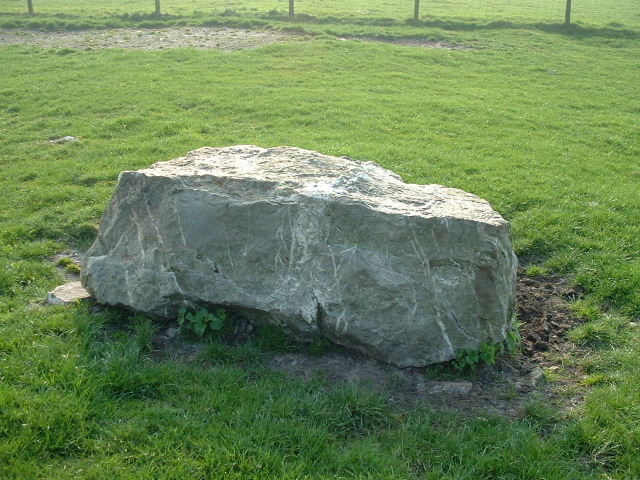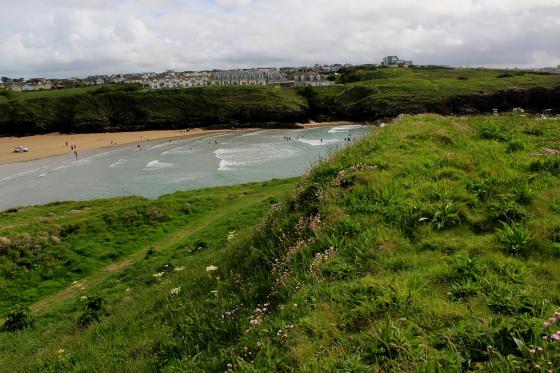
At one time this stone could be seen from Nine maidens. When it was standing it was over 7 feet tall. It was knocked down and broken for use in road building in about 1870?

At one time this stone could be seen from Nine maidens. When it was standing it was over 7 feet tall. It was knocked down and broken for use in road building in about 1870?

sunny march day 2003

I was pretty determined to spend ‘Christmas Day’ 2002 on a wind swept moor amongst ancient sites, and I managed to do just that.
I started with a quiet drive to the most famous quoit in East Cornwall, the huge Trethevy Quoit. I had seen it so many times in pictures; it was great to see it for real.
I moved onto toward the Hurlers but not before stopping at The Longstone Cross / Long Tom Cross. It may have once been a menhir that was then Christianised by carving a cross on its face. The stone stands alone, often amongst sheep roaming the moor, and on the horizon a line of old mine chimneys can been seen, marking the lode (course) of a copper vein. Even on this day there were lots of walkers and doggie people around The Hurlers, which was nice. It’s good to see people taking an interest (even a passing interest) in our history. Not only are the circles fascinating, but the whole place is steeped in history, from the Pipers, Rillaton Barrow, the Cheesewring, Stowe’s Pound, and Craddock moor sites, to the plethora of old mining ruins.
Without a map or compass you may be lucky enough to stagger across the fallen Craddock Moor Circle 1 km North West of the Hurlers whilst exploring Craddock Moor. Even with a map and compass you may not find them as the stones are all recumbent and are not visible from any distance. Further on is the tiny Craddock Moor Stone Row. There’s no easy way to describe how to get to this but if you wanna go try my instructions (or practice better compass reading that me – not hard!).
A few kilometres away from the Hurlers area, King Doniert’s Stone(s) stand in a beautiful walled enclosure, complete with stone benches. The Cornwall Heritage Trust could obviously teach English Heritage a thing or two.
I love ancient sites but sometimes you need a break so I went to the Eden Project on the 26th. This is not a criticism but of all the people who needed to go I wasn’t high on the list – I live a few kilometres from Kew Gardens and they are pretty similar in many ways. Anyway, go and see, and if you do, please spend a minute filling in a Gift Aid form, which means that they can claim 28% extra (over and above your admission fee) from the taxman.
On my way to Bodmin Moor I stopped at Lesquite Quoit but couldn’t properly explore, and had a wander around the huge Lanhydrock estate. The rest of the day was spent on the moor visiting the three stone circles of Stannon, Louden Hill, and Fernacre. Many of my stone counts didn’t match other people’s counts, the most interesting of which may have been Louden Hill where I counted 31 stones, as opposed to Craig Weatherhill’s 16/17 stones.
I also stumbled across something that could be interesting, or could just be a few stones in a quarter circle – I’ve taken the liberty of calling it Louden Hill 2?? I take no responsibility for it being just a couple of stones spotted by an eccentric walker on a lonely moor! I also came across a stone cist and two cairns between Louden Hill and Fernacre, which all seemed to align East-West to a stone in the background. As the night descended it led to the photos coming out very dark and now I scratch my head and wonder if it was just my imagination……a strange day.

Also known as “The Old man” or “The Blind Fiddler”
Visited 17.4.10.
There is a layby you can park in shortly beyond the B3274 / A39 junction (layby is on A39).
Once you park you need to walk about 300 metres up the road (north) until you see a metal gate. In this field (visible from gate) is The Magi stone. If you walk up the farm track the stone is on your left but in the next field.
The stone is a small, squarish stump of a stone – not much to write home about. I assume it is connected with the the Nine Maidens as it is shown on the O/S map as The Fiddler.
I don’t know what I was expecting, but it wasn’t this. I think I’d been spoilt by the sight of Men Gurta earlier in the day so I was a bit deflated to see the Magi Stone.
This must have been a very proud stone once apon a time but, alas, it now lies prostrate all on its own away from the maidens.
It was a gloomy evening it was getting quite dark so I didn’t take any photos of the stone
The Fiddler Menhir – 24.12.2002
Called the Fiddler on the OS map (ref SW939682) but also know as ‘The Blind Fiddler’, ‘The Old Man’ or ‘Magi Stone’. This menhir is 500m to the North East of the Nine Maidens, in alignment. The menhir was broken up some years ago, with part of it lying here.
Call me a conspiracy theorist but I get the feeling that something is up with the public access to this area. A public footpath should lead to the stone but there is no stile from the main road into the first field. If you go over the field gate you are then on the wrong side of a fence and in order to get into the field with the Fiddler in it (which does actually have a stile into it) you have to cross this fence the best you can. Very rum! The field gate also has a sign close-by saying “CASC Clay Shoot. Mondays” which I found less than welcoming. I think what I photographed is the remains of the stone, which is a pretty sad and messed up affair. The field also has several piles of rock in it, along with numerous sheep.





















































































